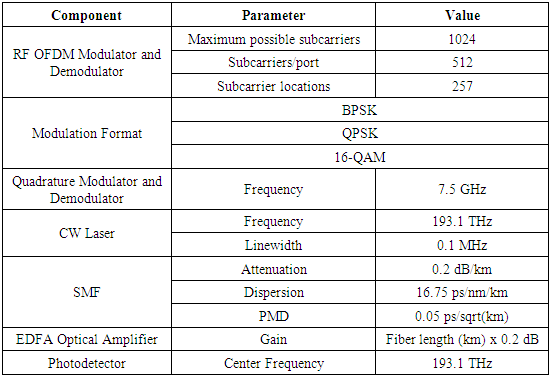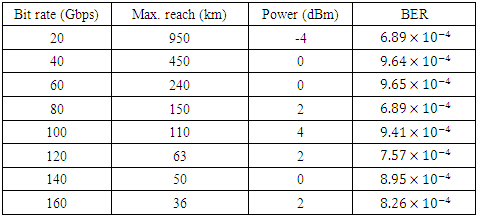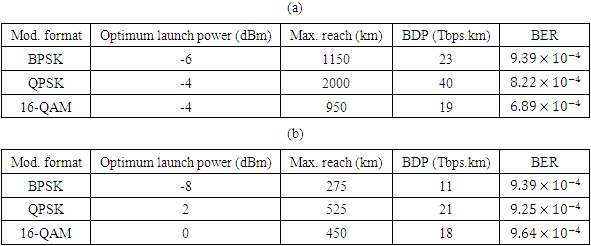| [1] | B. H. Ramaprasad, T. Schondienst, and V. M. Vokkarane, "Dynamic continuous and non-continuous advance reservation in SLICE networks," IEEE International Conference on Communications - Optical Networks and Systems, article no. 6883833, pp. 3319 – 3324, 2014. |
| [2] | P. Suppa and E. Zimeo, "A clustered approach for fast computation of betweenness centrality in social networks sign in or purchase," IEEE International Congress on Big Data, article no. 17, pp. 47 – 54, 2015. |
| [3] | J. Matoušek, G. Antichi, A. Lucansky, A. W. Moore, and J. Korenek, "Classbench-ng: Recasting classbench after a decade of network evolution," ACM/IEEE Symposium on Architectures for Networking and Communications, article no. 33, pp. 204 – 216, 2017. |
| [4] | Y. Kumar, H. Farooq, and A. Imran, "Fault prediction and reliability analysis in a real cellular network," IEEE Wireless Communications and Mobile Computing Conference, article no. 7986437, pp. 1090 – 1095, 2017. |
| [5] | A. Kortebi, P. Le Dain, and F. Duré, "Home network assistant: Towards better diagnostics and increased customer satisfaction," IEEE Global Information Infrastructure Symposium, article no. 6684354, 2013. |
| [6] | D. Campora, N. Neufeld, and R. Schwemmer, "Improvements in the LHCb DAQ," IEEE Real Time Conference, article no. 7097512, 2014. |
| [7] | S. Talarico, K. Makhijani, and P. Pillay-Esnault, "Efficient service auto-discovery for next generation network slicing architecture," IEEE Network Function Virtualization and Software Defined Networks Conference, article no. 7919471, pp. 26-36, 2017. |
| [8] | G. Aceto, V. Persico, A. Pescap´e, and G. Ventre, "Sometime: Software defined network-based available bandwidth measurement in MONROE," IEEE Network Traffic Measurement and Analysis Conference, article no. 8002918, pp. 1-6, 2017. |
| [9] | É. L. Ngoupé, S. Stoesel, C. Parisot, S. Hallé, P. Valtchev, O. Cherkaoui, and P. Boucher "A data model for management of network device configuration heterogeneity pierre boucher," IFIP/IEEE International Symposium on Integrated Network Management, article no. 7140472, pp. 1230-1233, 2015. |
| [10] | V. Lopez and L. Velasco, "Elastic optical networks," Springer, Switzerland, 2016. |
| [11] | P. Bhaumik, S. Zhang, P. Chowdhury, S. S. Lee, J. H. Lee, and B. Mukherjee, “Software-defined optical networks (SDONs): A survey,” Photonic Network Communication, vol. 28, no. 1, pp. 4–18, 2014. |
| [12] | X. Cao, N. Yoshikane, I. Popescu, T. Tsuritani, and I. Morita, “Software-defined optical networks and network abstraction with functional service design,” Journal of Optical Communication Network, vol. 9, no. 4, pp. C65–C75, 2017. |
| [13] | A. Mercian, M. P. McGarry, M. Reisslein, and W. Kellerer, “Software defined optical access networks (SDOANs): A comprehensive survey,” IEEE Communication Survey and Tutorials, vol. 18, no. 4, pp. 2738–2786, 2016. |
| [14] | M. Channegowda, R. Nejabati, and E. Simeonidou, “Software defined optical networks technology and infrastructure: Enabling software-defined optical network operations,” Journal of Optical Communication Network, vol. 5, no. 10, pp. A274–A282, 2013. |
| [15] | A. Aguado, E. Hugues-Salas, P. A. Haigh, J. Marhuenda, A. B. Price, P. Sibson, J. E. Kennard, C. Erven, J. G. Rarity, M. G. Thompson, A. Lord, R. Nejabati, and D. Simeonidou, “Secure NFV orchestration over an SDN-controlled optical network with time-shared quantum key distribution resources,” IEEE Journal of Lightwave Technolgy, vol. 35, no. 8, pp. 1357–1362, 2017. |
| [16] | X. Zhang, L. Guo, W. Hou, S. Wang, Q. Zhang, P. Guo, and R. Li, " Experimental demonstration of an intelligent control plane with proactive spectrum defragmentation in SD-EONs," Journal of Optical Express, vol. 25, no. 20, pp. 24837-24852, 2017. |
| [17] | A. Dupas, P. Layec, D. Verchere, and S. Bigo, “Bandwidth variable transmitter for software defined networks,” OSA, article no. W1I.6, 2017. |
| [18] | J. K. Fischer, S. Alreesh, R. Elschner, F. Frey, M. Nolle, C. Schmidt-Langhorst, and C. Schubert, “Bandwidth-variable transceivers based on four-dimensional modulation formats,” IEEE Journal of Lightwave Technolgy, vol. 32, no. 16, pp. 2886–2895, 2014. |
| [19] | M. S. Moreolo, J. M. Fàbrega, L. Nadal, and F. J. Vílchez, “Optical transceiver technologies for inter-data center connectivity,” International Conference on Transparent Optical Networks, article no. Mo.D1.4, 2014. |
| [20] | A. Dupas, P. Layec, E. Dutisseuil, S. Bigo, S. Belotti, S. Misto, S. Annoni ,Y. Yan, E. Hugues-Salas, G. Zervas, and D. Simeonidou, "Hitless 100 Gbit/s OTN bandwidth variable transmitter for software-defined networks," Optical Fiber Communications Conference and Exhibition, article no. Th3l.1, 2016. |
| [21] | N. Sambo, P. Castoldi, A. D’Errico, E. Riccardi, A. Pagano, M. S. Moreolo, J. M. Fàbrega, D. Rafique, A. Napoli, S. Frigerio, E. H. Salas, G. Zervas, M. Nölle, J. K. Fischer, A. Lord, and J. P.F.-P Gimenez, " Next generation sliceable bandwidth variable transponders," IEEE Communications Magazine, vol. 53, no. 2, pp. 163-171, 2015. |
| [22] | W. Shieh and I. Djordjevic, "OFDM for optical communications," Massachusetts, USA, Elsevier, 2010. |
| [23] | X. Zhou and C. Xie, "Enabling technologies for high spectral-efficiency coherent optical communication networks" New Jersey, USA, John Wiley and Sons, 2016. |
| [24] | J. He, F. Long, R. Deng, J. Shi, M. Dai, and L. Chen, “Flexible multiband OFDM ultra-wideband services based on optical frequency combs,” IEEE Journal of Optical Communication and Networking, vol. 9, no. 5, pp. 393–400, 2017. |
| [25] | B. C. Chatterjee, N. Sarma, and E. Oki, "Routing and spectrum allocation in elastic optical networks: A tutorial," IEEE Communication Survey and Tutorials, vol. 17, no. 3, pp. 1776–1800, 2015. |
| [26] | Z. Yang, S. Yu, L. Chen, J. Li, Y. Qiao, and W. Gu, “CPFSK scheme with multiple modulation indices in optical OFDM communication system,” IEEE Photonics Journal, vol. 5, no. 6, 2013. |
| [27] | J. Schroder, L. B. Du, J. Carpenter, B. J. Eggleton, and A. J. Lowery, “All-optical OFDM with cyclic prefix insertion using flexible wavelength selective switch optical processing,” IEEE Journal of Lightwave Technolgy, vol. 32, no. 4, pp. 752–759, 2014. |
| [28] | D. F. Hewitt, “Orthogonal frequency division multiplexing using baseband optical single sideband for simpler adaptive dispersion compensation,” Optical Fiber Communication and the National Fiber Optic Engineers Conference, article no. OME7, 2007. |
| [29] | W. Peng, X. Wu, V. R. Arbab, B. Shamee, J. Y. Yang; L. C. Christen, K. M. Feng, A. E. Willner, and S. Chi, “Experimental demonstration of 340 km SSMF transmission using a virtual single sideband OFDM signal that employs carrier suppressed and iterative detection techniques,” Optical Fiber Communication and the National Fiber Optic Engineers Conference, article no. OMU1, 2008. |
| [30] | J. Zhang, J. Yu, F. Li, N. Chi, Z. Dong, and X. Li, “11 × 5 × 9.3 Gb/s WDM-CAP-PON based on optical single-side band multi-level multi-band carrier-less amplitude and phase modulation with direct detection,” Journal of Optical Express, vol. 21, no. 16, pp. 18842–18848, 2013. |
| [31] | F. Li, J. Yu, Y. Fang, Z. Dong, X. Li, and L. Chen, “Demonstration of DFT-spread 256QAM-OFDM signal transmission with cost-effective directly modulated laser,” Journal of Optical Express, vol. 22, no. 7, pp. 8742–8748, 2014. |
| [32] | G. Zhang, M. D. Leenheer, A. Morea, and B. Mukherjee, “A survey on OFDM-based elastic core optical networking,” IEEE Communication Survey and Tutorials, vol. 15, no. 1, pp. 65–87, 2013. |
| [33] | W. Shieh, H. Bao, and Y. Tang, “Coherent optical OFDM: Theory and design,” Optics Express, vol. 16, no. 2, p. 841, 2008. |
| [34] | A. Sano, A. Sano, E. Yamada, H. Masuda, E. Yamazaki, T. Kobayashi, E. Yoshida, Y. Miyamoto, R. Kudo, K. Ishihara, and Y. Takatori, “No-guard-interval coherent optical OFDM for 100-Gb/s long-haul WDM transmission,” IEEE Journal of Lightwave Technology, vol. 27, no. 16, pp. 3705–3713, 2009. |
| [35] | X. W. Yi, N. K. Fontaine, R. P. Scott, and S. J. B. Yoo, “Tb/s coherent optical OFDM systems enabled by optical frequency combs,” IEEE Journal of Lightwave Technology, vol. 28, no. 14, pp. 2054–2061, 2010. |
| [36] | R. Zhou, R. Maher, M. Paskov, D. Lavery, B. C. Thomsen, S. J. Savory, and L. P. Barry, “80-km coherent DWDM-PON on 20-GHz grid with injected gain switched comb source,” IEEE Photonic Technology Letters, vol. 26, no. 4, pp. 364–367, 2014. |
| [37] | J. M. Fabrega, M. S. Moreolo, F. J. Vilchez, K. Christodoulopoulos, E. Varvarigos, and J. P. Fernandez-Palacios, “Experimental validation of MTU-BRAS connectivity with DMT transmission and coherent detection in flexgrid metro networks using sliceable transceivers,” Optical Fiber Communications Conference and Exhibition, article no. Th3H.4, 2015. |
| [38] | M. S. Moreolo, S. Member, L. Nadal, and J. M. Fabrega, “DSP-enabled optical OFDM for multiple-format and multi-rate / distance transmission,” International Conference on Transparent Optical Networks, article no. We.A1.5, 2015. |
| [39] | M. S. Moreolo, J. M. Fabrega, and L. Nadal, “Multi-adaptive S-BVT for software defined optical networks,” International Conference on Transparent Optical Networks, article no. We.A1.3, 2016. |
| [40] | M. S. Moreolo, J. M. Fabrega, L. Nadal, F. J. Vílchez, A. Mayoral, and R. Vilalta, R. Munoz, R.Casellas, R. Martinez, M. Nishihara, T. Tanaka, T. Takahara, J. C. Rasmussen, C. Kottke, M. Schlosser, R. Freund, F. Meng, S. Yan, G. Zervas, D. Simeonidou, Y. Yoshida, and K. I. Kitayama “SDN-enabled sliceable BVT based on multicarrier technology for multi-flow rate / distance and grid adaptation,” IEEE Journal of Lightwave Technolgy, vol. 34, no. 6, pp. 1516–1522, 2016. |
| [41] | J. M. Fabrega, M. S. Moreolo, A. Mayoral, R. Vilalta, R. Casellas, R. Martinez, R. Munoz, Y. Yoshida, K. Kitayama, Y. Kai, M. Nishihara, R. Okabe, T. Tanaka, T. Takahara, J. C. Rasmussen, N. Yoshikane, X. Cao, T. Tsuritani, I. Morita, K. Habel, R. Freund, V. Lopez, A. Aguado, S. Yan, D. Simeonidou, T. Szyrkowiec, A. Autenrieth, M. Shiraiwa, Y. Awaji, and N. Wada, “Demonstration of adaptive SDN orchestration: A real-time congestion-aware services provisioning over OFDM-based 400G OPS and flexi-WDM OCS,” IEEE Journal of Lightwave Technolgy, vol. 35, no. 3, pp. 506–512, 2017. |



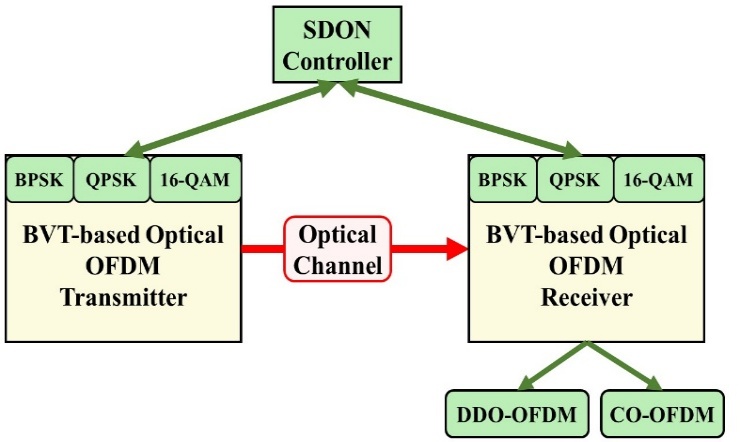
 The maximum slice capacity was nearly 50 Gbps, and 30 Gbps with B2B, and after 185 km transmission distance, respectively.In 2016, Moreolo et al. [40] proposed a high capacity sliceable BVT based on MCM technology and DD which was suitable for metropolitan regional elastic optical network. The sliceable BVT was controlled and adapted by SDN controller to efficiently resource usage. The sliceable BVT adaptation, programmability, and configurability were confirmed through the DSP operations by adjusting the bandwidth, rate/distance, modulation type, and other key functionalities. The transceiver advanced functionalities were experimentally demonstrated in a four node optical mish network, with the combination of SDN controlling.In 2017, Fabrega et al. [41] proposed and experimentally demonstrated an adaptive SDN orchestrator which controls multiple domain optical networks (optical packet switching, optical circuit switching), each domain controlled by its own SDN. Multiple technologies were demonstrated using an adaptive programmable reconfigurable sliceable BVT at each transmission over the optical network. sliceable BVT was designed based on MCM.
The maximum slice capacity was nearly 50 Gbps, and 30 Gbps with B2B, and after 185 km transmission distance, respectively.In 2016, Moreolo et al. [40] proposed a high capacity sliceable BVT based on MCM technology and DD which was suitable for metropolitan regional elastic optical network. The sliceable BVT was controlled and adapted by SDN controller to efficiently resource usage. The sliceable BVT adaptation, programmability, and configurability were confirmed through the DSP operations by adjusting the bandwidth, rate/distance, modulation type, and other key functionalities. The transceiver advanced functionalities were experimentally demonstrated in a four node optical mish network, with the combination of SDN controlling.In 2017, Fabrega et al. [41] proposed and experimentally demonstrated an adaptive SDN orchestrator which controls multiple domain optical networks (optical packet switching, optical circuit switching), each domain controlled by its own SDN. Multiple technologies were demonstrated using an adaptive programmable reconfigurable sliceable BVT at each transmission over the optical network. sliceable BVT was designed based on MCM.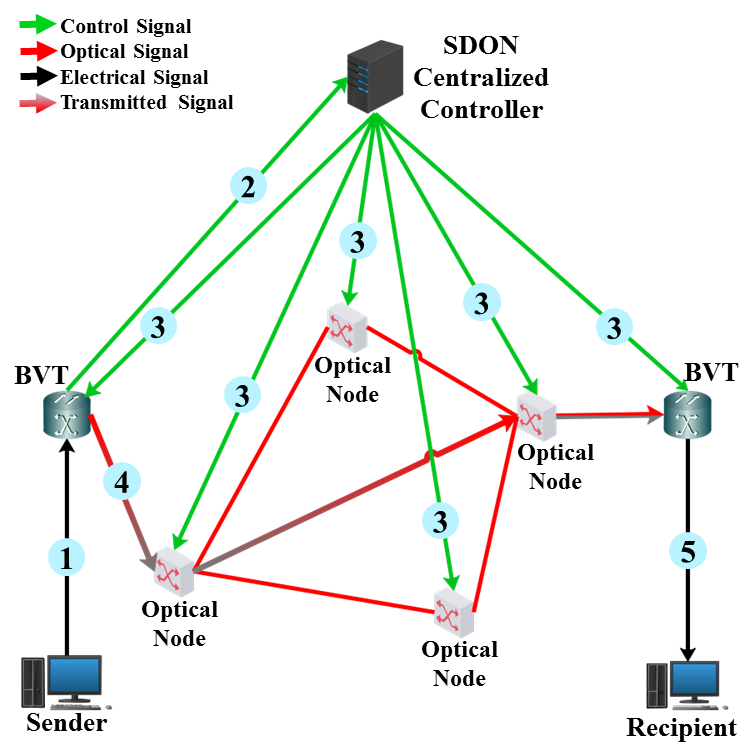



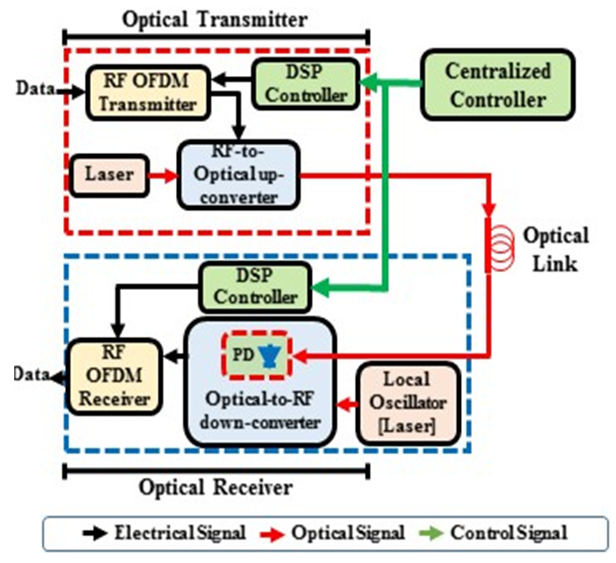
 which is lower than the maximum acceptable BER. The optimum launch power and longest reach at 20 Gbps are 12 dBm and 31 km, respectively, with
which is lower than the maximum acceptable BER. The optimum launch power and longest reach at 20 Gbps are 12 dBm and 31 km, respectively, with  which is again lower than the maximum acceptable BER.
which is again lower than the maximum acceptable BER.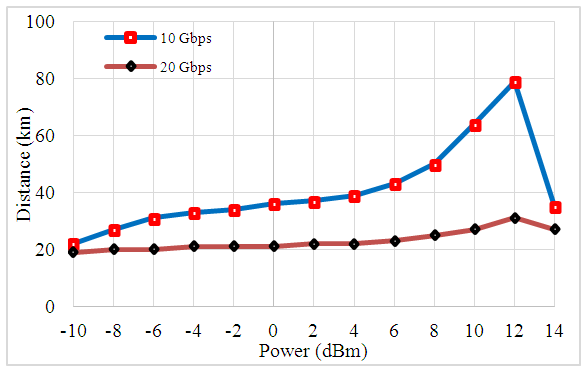
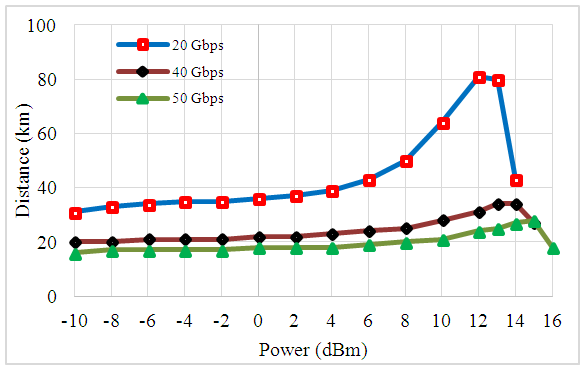
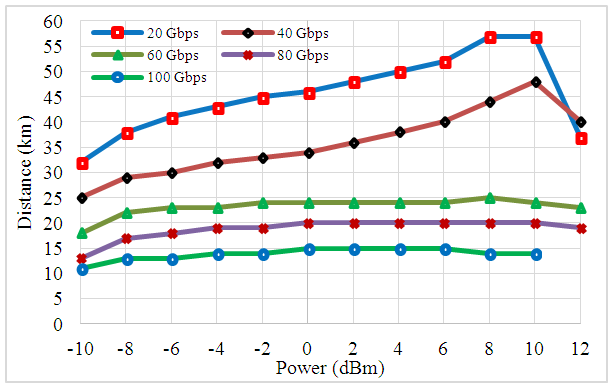
 and
and  respectively. The QPSK modulation format is tested at four different bit rates (20, 40, 60, and 80 Gbps) and the results are displayed in Figure 10. Investigating the results in this figure reveals that a maximum transmission of 2000, 525, 300, and 170 km are achieved with 20, 40, 60, and 80Gbps, respectively. The corresponding optimum power is -4, 2, 0, and 4dBm, respectively. The corresponding BER are listed in Table 5. The main conclusions drawn from Table 5 are(i) Lower maximum reach is obtained of higher bit rate. At 40, 60, and 80 Gbps bit rates, the maximum reach is about 0.26, 0.15, and 0.09 of that the 20 Gbps bit rate, respectively.(ii) The BDP is 40, 21, 18, and 13.6 Tbps.km at bit rate of 20, 40, 60, and 80 Gbps, respectively.
respectively. The QPSK modulation format is tested at four different bit rates (20, 40, 60, and 80 Gbps) and the results are displayed in Figure 10. Investigating the results in this figure reveals that a maximum transmission of 2000, 525, 300, and 170 km are achieved with 20, 40, 60, and 80Gbps, respectively. The corresponding optimum power is -4, 2, 0, and 4dBm, respectively. The corresponding BER are listed in Table 5. The main conclusions drawn from Table 5 are(i) Lower maximum reach is obtained of higher bit rate. At 40, 60, and 80 Gbps bit rates, the maximum reach is about 0.26, 0.15, and 0.09 of that the 20 Gbps bit rate, respectively.(ii) The BDP is 40, 21, 18, and 13.6 Tbps.km at bit rate of 20, 40, 60, and 80 Gbps, respectively.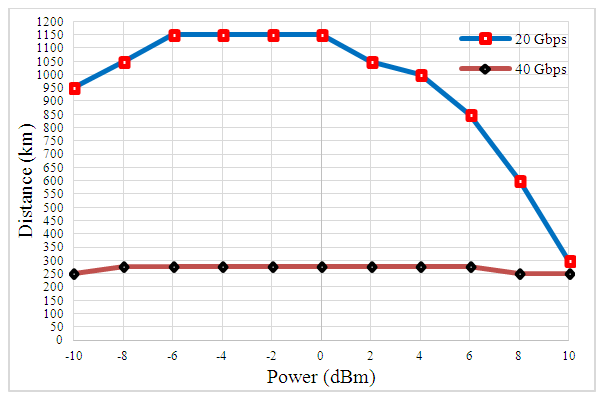
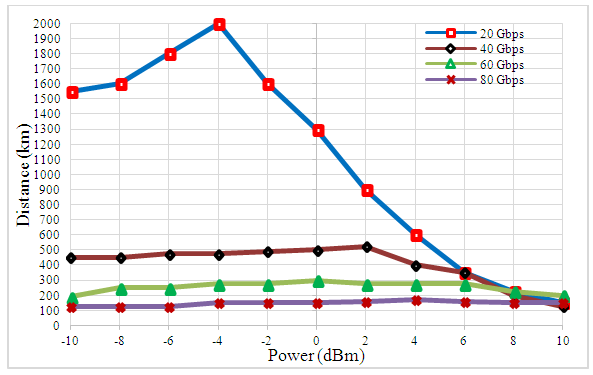
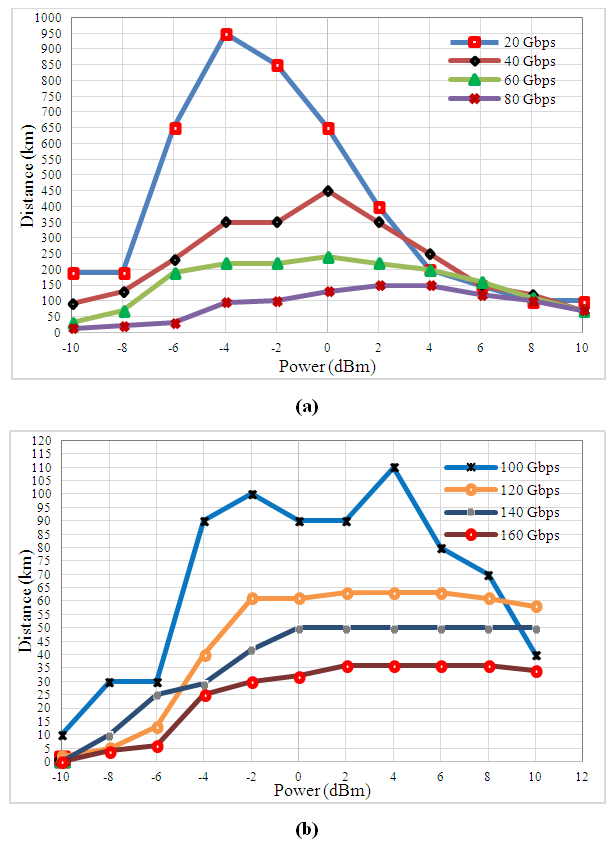
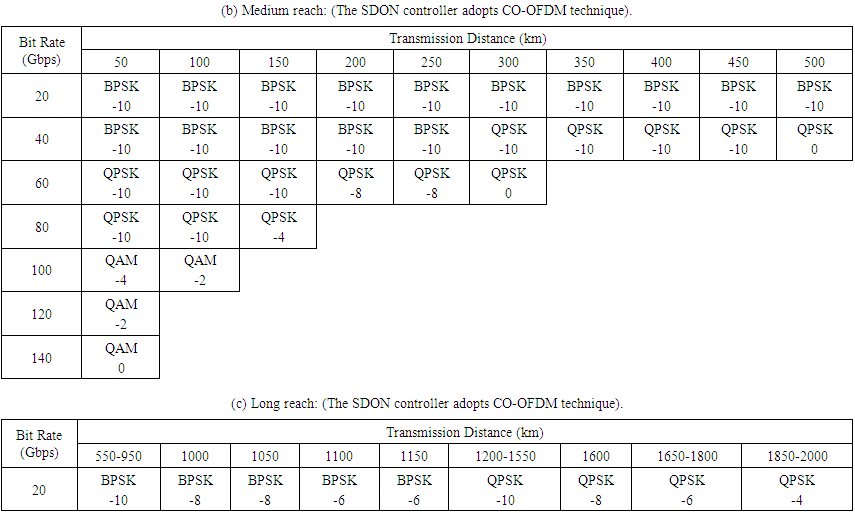
 Abstract
Abstract Reference
Reference Full-Text PDF
Full-Text PDF Full-text HTML
Full-text HTML